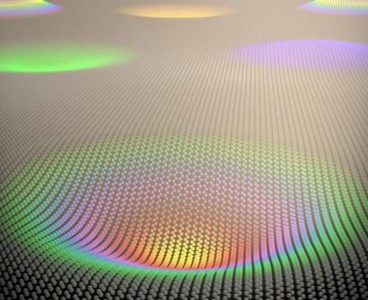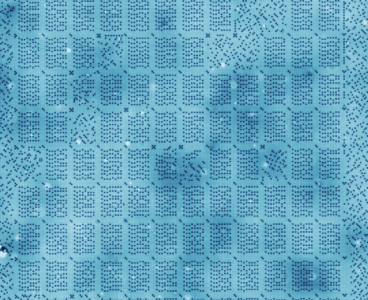TU Delft researchers have developed a new approach for calculating fast and accurate the solar energy potential of surfaces in the urban environment. The new approach can significantly help architects and urban planners to incorporate photovoltaic (solar power) technology in their designs. The findings were presented on Monday 4 February in Nature Energy. Buildings, trees…
New Graphene Technology Enhances Electronic Displays
With virtual reality (VR) sizzling in every electronic fair, there is a need for displays with higher resolution, frame rates, and power efficiency. Now, a joint collaboration of researchers from SCALE Nanotech, Graphenea, and TU Delft have used graphene to make reflective-type displays that operate faster and at much higher resolution than existing technologies. Displays…
Newly Discovered Magnetic State Could Lead to Green IT Solutions
Magnetic skyrmions are magnetic swirls that may lead to new solutions combining low-energy consumption with high-speed computational power and high-density data storage, revolutionizing information technology. A team from Delft University of Technology, in collaboration with the University of Groningen and Hiroshima University, has discovered a new, unexpected magnetic state, which is related to these skyrmions.…
Graphene Break Junction Aids Disease Treatment
Novel Flying Robot Mimics Rapid Insect Flight
Researcher Proposes Superheroes Give Graphene a Try
One superpower that gains constant attention is that of impenetrability, a power possessed by superheroes like Luke Cage, Wonder Woman, Superman, and Colossus. In a recent paper in Advances in Physiology Education, Barry W. Fitzgerald considers how Colossus’ skin might work. Colossus is a member of the X-Men and has appeared in films such as…
Cracking the Problem of Mass Produced Molecular Junctions
Nanogap electrodes, basically pairs of electrodes with a nanometer-sized gap between them, are attracting attention as scaffolds to study, sense, or harness molecules, the smallest stable structures found in nature. So far, this has been realised using the common methods of mechanically controlled break junctions, scanning tunneling microscopy-based break junctions,or electromigrated break junctions. These techniques,…
Nickelate Nano-switches Controlled with Laser Light
Dr. Giordano Mattoni, quantum researcher at TU Delft, and his collaborators have shown that the nano-electronic phase transition in a class of materials known as nickelates can be controlled by laser light. Their findings, which were published in Physical Review Materials, are an important step in the field of new materials for electronics. Nickelates are…
Quantum Race Accelerates Development of Silicon Quantum Chip
The worldwide race to create more, better and reliable quantum processors is progressing fast, as a team of TU Delft scientists led by Professor Vandersypen has realised yet again. In a neck-and-neck race with their competitors, they showed that quantum information of an electron spin can be transported to a photon, in a silicon quantum…
Quantum Race Accelerates Development of Silicon Quantum Chip
The worldwide race to create more, better and reliable quantum processors is progressing fast, as a team of TU Delft scientists led by Professor Vandersypen has realised yet again. In a neck-and-neck race with their competitors, they showed that quantum information of an electron spin can be transported to a photon, in a silicon quantum…
Researchers Create Very Small Sensor Using ‘White Graphene’
Researchers from TU Delft in The Netherlands, in collaboration with a team at the University of Cambridge (UK), have found a way to create and clean tiny mechanical sensors in a scalable manner. They created these sensors by suspending a two-dimensional sheet of hexagonal boron nitride (h-BN), or ‘white graphene’ over small holes in a…
Revolutionary New Laser Holds Key to Microwave Radiation
Lasers are everywhere nowadays: doctors use them to correct eyesight, cashiers to scan your groceries, and quantum scientist to control qubits in the future quantum computer. For most applications, the current bulky, energy inefficient lasers are fine, but quantum scientist work at extremely low temperatures and on very small scales. For over 40 years, they…
Graphene Balloons Show Off Their Colors
Researchers from the Graphene Flagship have found a new potential application for graphene: mechanical pixels. By applying a pressure difference across graphene membranes, the perceived color of the graphene can be shifted continuously from red to blue. This effect could be exploited for use as colored pixels in e-readers and other low-powered screens. The research…
Graphene Balloons Show Their Colors
Researchers from the Graphene Flagship have found a new potential application for graphene: mechanical pixels. By applying a pressure difference across graphene membranes, the perceived color of the graphene can be shifted continuously from red to blue. This effect could be exploited for use as colored pixels in e-readers and other low-powered screens. The research…
Smallest Hard Disk to Date Writes Information Atom by Atom
Every day, modern society creates more than a billion gigabytes of new data. To store all this data, it is increasingly important that each single bit occupies as little space as possible. A team of scientists at the Kavli Institute of Nanoscience at Delft University reduced storage to the ultimate limit: They stored one kilobyte…










